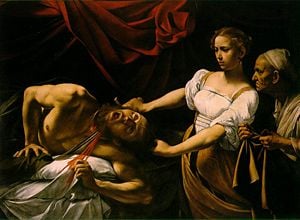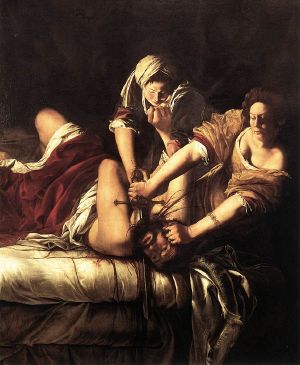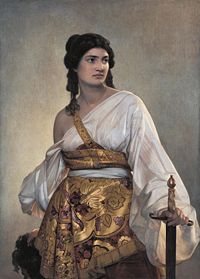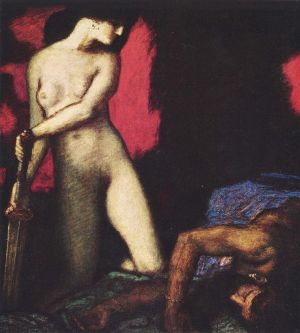Book of Judith
- "Judith" redirects here.

The Book of Judith is a deuterocanonical book, included in the Roman Catholic and Eastern Orthodox Bibles, but excluded by Jews and Protestants. Although artfully constructed the book contains numerous historical anachronisms.
The story revolves around Judith, a daring and beautiful widow, who is upset with her Jewish countrymen for being unwilling to engage their foreign conquerors. During the final stages of siege which has convinced her city of Bethuliah to surrender, she travels to the camp of the enemy general, Holofernes and seductively ingratiates herself to him. Soon, as he lies in a drunken stupor, she decapitates him, then takes his head back to her fearful countrymen. The Assyrians, having lost their leader are soon routed and Israel is saved. Though she is courted by many, Judith remains quietly unmarried for the rest of her life.
The name Judith (Hebrew: יְהוּדִית, Standard Yehudit Tiberian Yəhûḏîṯ ; "Praised" or "Jewess", Arabic: يهوديت Yahūdīt) is the feminine form of Judah.
Setting and date
As a historical tale, Judith's scenes are enlivened and given immediacy by their setting. Rather than a work of sacred history, however, it is best understood as a type of pious historical novels. "Nebuchadnezzar" is portrayed as a "King of Assyria" who reigns in Nineveh, but the real king of that name was a Babylonian. Nor can he be the Assyrian king of the same name, for the setting is clearly after the destruction of the Temple of Jerusalem. With the very first words of the tale—"In the twelfth year of the reign of Nebuchadnezzar, who reigned over the Assyrians in Nineveh"—compilers of the Jewish Encyclopedia argue that the narrator sets his story in the equivalent of "once upon a time."
The story's geographical setting in a city called "Bethulia," a possible pun on the Hebrew word for "virgin," is also believed by many to be fictional, but some suggest either Shechem or Meselieh as the story's actual setting. The historical Nebuchadnezzar II actually did conquer Judah after the northern kingdom of Israel had been destroyed by the Assyrians, but here is foiled.
Scholars believe the book reflects the cultural of Hasmonean dynasty, when stories of heroic opposition to Gentile kingdoms were popular. The mostly like date of the Book of Judith is sometime in the later second century B.C.E. Few
The Book of Judith was probably written in Hebrew. However the oldest versions of its actual text are Greek translations included in the Septuagint version of the Hebrew Bible. Although the book was later rejected by rabbinical authorities, it was recognized as canonical by Christians until the Protestant Reformation, which generally rejected it. Even though the Book of Judith is not part of the official Jewish religious canon, it regained popularity among Jews in the medieval period and remains popular today.
Summary
Nebuchadnezzar grows angry with the people of the Levant who resist his rule and vows to destroy them. He assigns his military commander Holofernes to this task, and a great army sweeps down from Mesopotamia into Syria and Lebanon toward Israel. It its path, the nations immediately surrender and beg for peace. The Israelites fast and pray to God for deliverance, the town of Bethulia particularly, since it stands in the way of the mighty army's path to Jerusalem. (1-4)
Holoferenes in amazed the the Israelites would have the courge to resist him. Achior, the leader of all the Ammonites, briefs him on Israel's sacred history and declares that Israel will be invincible unless it sins against God. "Who is God except Nebuchadnezzar?" Holefernes replies. Here therebound has Achior bound and taken to Behulia, where he can share the Israelites' fate. The Ammonite leader is treated with hospitality by the citizens of the city and welcomed into their assembly. [1] Holefernes arrays his troops for battle, but the Edomites in his coalition convince him lay seige to the city instead, by taking control of its water supply, which lies outside the city walls. After a little more than a month, the people of Bethulia are ready to surrender, but their mayor, Uzziah, convinces them to hold out for five more days. If God does not deliver them by the fortieth day of the siege, he vows to accede to their wishes and surrender to Holofernes' forces. (5-7)
It is only now that the lovely, pious widow Judiah appears on the scene. She prophetically proclaims that surrender to Holofernes' would be sin. "If we are captured all Judea will be captured and our sanctuary will be plundered; and he (God) will exact of us the penalty for its desecration," she argues. Judith declares that she herself will become God's agent of deliverance. Judith prays desperately to God to allow her "deceitful words" defeat the Assyrians, who plan to defile God's covenant and destroy his Temple. She then attires herself glamorously, receiving the praise of the people of Bethulia as she leaves through the city gate together with her maid. She is immediately arrested by an Assyrian patrol but convinces them that she has useful information for Holefernes. She is consequently taken to him, amidst great excitement on account of her unrivaled beauty. (8-10)
Holefernes assures Judith that she will not be harmed if she is willing to serve his master, Nebuchadnezzar. She confirms the report of Alchior the Ammonite regarding the Israelites' invincibility. However, she reports that the people of both Behuliah and Jerusalem have been so hard pressed by the siege that they are about to consume various food items dedicate to God. She explains that this very situation prompted her own decision to come to the Assyrian camp, rather than share in the Israelites' now certain doom. She promises to act as Holefernes' spy to tell him when these sins have been committed, and thus when it is safe for him to attack. Holefernes agrees to the plan and marvels at Judith's wisdom, promising her rich rewards. He offers her a sumptuous meal, but she piously declines to eat the un-kosher food. She has brought her own supply of food, however, and survives on this while she stays in the camp for three days. On the fourth days, Holofernes determines that he must have his way sexually with the lovely Judith. She accepts his offer to dine and "become like one of the the daughters of the Assyrians," reclining before him as they eat. The aroused and overjoyed Holofernes drinks a huge quantity of wine. (11-12)
When Holofernes' servants leave him and Judith alone to have some privacy, he immediate falls asleep. Taking Holofernes' sword from where it hung above his bed, she then prayed to God for strength decapitated her enemy. Summoning her maid, they placed Holofernes' head in Judith's food bag and made good their escape, a feat made easy by the trusted Judith's previous nightly prayer vigils outside the camp. Returning to Bethuliah, Judith produced Holofernes' head for all to see, to the great joy and praise of the Israelites. Achior the Ammonite confirms the identity of the head. He is so impressed by God's miraculous work through Judith that he immediate accepts circumcision and becomes a Jew. The Assyrians, meanwhile, have discovered Judith's treachery and are thrown into disarray. Following Judith's advise, the men of Bethulia attack, mustering their fellow Israelites to dive the enemy back even beyond Damascus. Judith receives high honors and adulation. Even Jerusalem's high priest Joakim came to pay his respects. Judith then retired to her home and lived the rest of her life as a widow, despite many offers of marriage. She died at the age of 105. (13-16)
Judith in later artistic renditions
The Anglo-Saxon abbot Aelfric wrote a homily about Judith. See Judith (homily). A poem Judith in Old English also treats the beheading of Holofernes. See Judith (poem).
In the Renaissance, the story of Judith became an exemplum of the courage of local people against tyrannical rule from afar. The Dalmatian Humanist Marko Marulić (1450-1524) reworked the Judith story in his Renaissance literary work, Judita. His inspiration came from the contemporary heroic struggle of the Croats against the Ottomans in Europe.
Judith and Holofernes, the famous bronze sculpture by Donatello, bears the implied allegorical subtext that was inescapable in Early Renaissance Florence, that of the courage of the commune against tyranny. Michelangelo painted Judith in the corner of the Sistine chapel. Other Italian painters who took up the theme include Botticelli, Giorgione, Titian, Paolo Veronese, Caravaggio, Leonello Spada, Bartolomeo Manfredi and Artemisia Gentileschi. In the north, Lucas Cranach, Rembrandt and Peter Paul Rubens used the story. In European art, Judith is normally accompanied by her maid at her shoulder, which helps to distinguish her from Salome, who also carries her head on a silver charger (plate). However a Northern tradition developed whereby Judith had both a maid and a charger, famously taken by Erwin Panofsky as an example of the knowledge needed in the study of iconography.

In the Renaissance, especially in Germany an interest developed in female "worthies" and heroines, to match the traditional male sets. Subjects combining sex and violence were also popular with collectors. Like Lucretia, Judith was the subject of a disproportionate number of old master prints, sometimes shown nude. Barthel Beham engraved three compositions of the subject, and other of the "Little Masters" did several more. Jacopo de' Barberi, Girolamo Mocetta after a Mantegna design, Parmigianino, and Jacques Callot also made prints of the subject. The first reproductive print of his work commissioned by Rubens was an engraving by Cornelius Galle of his violent "large Judith," now in the Palazzo Barberini.[2] Judith was one of the virtuous women whom Van Beverwijck mentioned in his published apology (1639) for the superiority of women to men.[3] Judith was depicted by Eglon van der Neer.
Alessandro Scarlatti wrote an oratorio in 1693, La Giuditta; Juditha triumphans was written in 1716 by Antonio Vivaldi; Mozart composed in 1771 La Betulia Liberata (KV 118), to a libretto by Pietro Metastasio. Judith is by Russian composer Alexander Serov.
In 1841 Friedrich Hebbel published his closet drama Judith, but in the English language, blanket censorship of all biblical subjects on the stage set the theme off-limits until the twentieth century,[citation needed] when the British playwright Howard Barker examined the Judith story and its aftermath, first in the scene "The Unforeseen Consequences of a Patriotic Act," as part of his collection of vignettes, The Possibilities. Barker later expanded the scene into a short play Judith.
In 2007 Philippe Fénelon (French, born in 1952) composed Judith, an opera with one act and five pictures (monodrama), based on a booklet adaptated from the Friedrich Hebbel's drama, in German (creation on 28/11/07 at the Pleyel Room, Paris, ordered by the Opera National de Paris).
ReferencesISBN links support NWE through referral fees
- ↑ Ordinarily Ammonites were forbidden by Jewish law from such hospitality.
- ↑ H Diane Russell;Eva/Ave; Women in Renaissance and Baroque Prints; Nos 20-32, National Gallery of Art, Washington, 1990; isbn 155861 0391
- ↑ Loughman & J.M. Montias (1999) Public and Private Spaces. Works of Art in Seventeenth-Century Dutch Houses, p. 81.
External links
- The Book of Judith Full text (also available in Arabic)
- Text of the Book of Judith
- Another text, this one including a link to download as a single document
- Jewish Encyclopedia: Judith
- Catholic Encyclopedia: Book of Judith
- World Wide Study Bible: Judith
- A Historical Commentary on the Book of Judith
| Preceded by: Tobit |
Books of the Bible |
Succeeded by: Esther |
| |||||||||||||||||
Credits
New World Encyclopedia writers and editors rewrote and completed the Wikipedia article in accordance with New World Encyclopedia standards. This article abides by terms of the Creative Commons CC-by-sa 3.0 License (CC-by-sa), which may be used and disseminated with proper attribution. Credit is due under the terms of this license that can reference both the New World Encyclopedia contributors and the selfless volunteer contributors of the Wikimedia Foundation. To cite this article click here for a list of acceptable citing formats.The history of earlier contributions by wikipedians is accessible to researchers here:
The history of this article since it was imported to New World Encyclopedia:
Note: Some restrictions may apply to use of individual images which are separately licensed.

